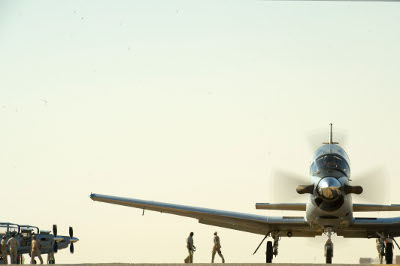Human Interest
Leaving a legacy of air power

Milestones are being achieved and partnerships are being strengthened here at Combat Operating Base Speicher (formerly Al Sahra Airfield) in Tikrit, Iraq, home of the 52nd Expeditionary Flying Training Squadron, US Air Force.
Building a new air force
Advising Iraqi forces is nothing new to the Iraq Training and Advising Mission component of the U.S. Air Force. Since the troop drawdown began early 2009, Iraqi forces have started to take the lead in air combat operations, but not without help.
The 52nd Expeditionary Flying Training Squadron is instructing the Primary Pilot Training courses and the Primary Instructor Pilot in the T-6A, the same trainer that the USAF uses back home.
Once Iraqi officers attend a short training course on the basics of flying, they then attend the Primary Pilot Training course. The approximately one year long course will produce pilots who earn their pilot wings. Graduates of the primary pilot course will attend the six month instructor course. Upon instructor pilot graduation, graduates are charged with the task of training the upcoming student pilots.
Flying training in the T-6A began here in December of 2009. Since then, each program has graduated classes, with five classes currently in session.
Constant improvement

An Iraqi Airman marshals in a T-6 Texan piloted by an Iraqi student pilot instructor at Combat Operating Base Speicher, Tikrit, Iraq on June 29, 2011. Students will graduate the course and become some of the first Iraqi instructor pilots. (U.S. Air Force photo by Staff Sergeant David Salanitri)
Just like formal training in the U.S., courses here are constantly improving.
“Within the past week, we’ve had three first-time events here,” said Maj. Mark Loranger, assistant deputy of operations and instructor pilot.
Last week we had our first all-Iraqi formation in the air and first student instructor fly a solo mission; today we had our first student pilot fly a mission on his own.
According to U.S. Airmen leading the first iterations of the Iraqi pilot training, the Iraqi air force is one-step closer to being self-sustaining.
“In the next one-two months, the Iraqi instructors who have graduated our course will take the lead in the squadron,” said Maj. Sean Long, 52nd EFTS instructor pilot.
The Iraqi leadership is already customizing the squadron to their liking. This is not our program, it’s Iraq’s.
We don’t want to duplicate the program we have in the U.S. because the Iraqi air force is not the U.S. Air Force. Their challenges are different.
Growing pains
Though many things are going well here, not everything is smooth sailing. Local challenges for the Iraqi air force students are present in the form of insurgent violence in their home towns. When a pilot arrives to training in the U.S., he’s able to focus on training without having to worry about local violence in their family’s home town.
Here, it’s different. Students have obligations to their families and their safety.
To overcome set backs in training due to students having to tend to their families, classes are broken down into smaller numbers and the courses are slightly longer so that the entire operation doesn’t stop when one student has to go home.
As training continues, relationships develop between fellow pilots—USAF and Iraqi air force.
“We’re creating a sustaining legacy,” said Lt. Col. Andy Hamann, 52nd EFTS commander.
We currently have 16 young Iraqi officers in our course. They’ll graduate from the instructor course and go on to teach many Iraqi pilots long after we’re gone. Ten to 15 years from now, we hope to find ourselves flying next to them as allies and that will be our legacy.
Staff sergeant David Salanitri USAF contributed this article from US Air Forces Central News.
Featured image: An Iraqi Air Force student instructor pilot taxis his T-6A Texan II out to the runway June 29, 2011, at Combat Operating Base Speicher in Tikrit, Iraq. Students graduating from this course will become some of the first U.S. Air Force-trained Iraqi instructor pilots. The T-6 is the primary training aircraft of the unit. Photo: US Air Force/SSgt David Salanitri
[amazon_carousel widget_type=”ASINList” width=”500″ height=”250″ title=”” market_place=”US” shuffle_products=”True” show_border=”False” asin=”B00375LOEG, 0451947673, 0800733940, 0062073303, 1595230734, 1936218003, 0981559662, 1935071874, 1932172378″ /]
-

 Civilization5 days ago
Civilization5 days agoTrump’s Venezuela Gamble and America’s Shifting National Security Strategy
-

 Civilization5 days ago
Civilization5 days agoOperation Absolute Resolve: Anatomy of a Modern Decapitation Strike
-

 Civilization5 days ago
Civilization5 days agoTen Reasons To Cheer the Arrest of Maduro
-

 Executive23 hours ago
Executive23 hours agoWaste of the Day: Can You Hear Me Now? No.
-

 Civilization23 hours ago
Civilization23 hours agoTrump’s version of the Monroe Doctrine
-

 Civilization2 days ago
Civilization2 days agoOne Fell Swoop: Lawsuit Eyes Death Blow to Racial Preferences
-

 Civilization2 days ago
Civilization2 days agoTrump’s New Doctrine of Precision Deterrence
-

 Civilization12 hours ago
Civilization12 hours agoThe Snatch and Grab of Maduro Was Not ‘Illegal’














The so-called ‘T-6 Texan’ in the photo is actually a Beechcraft with a turboprop engine. A T-6 uses conventional landing gear and a radial engine. It was phased out as a trainer decades ago.
Elliot–That is an incorrect statement. The T6 Texan is used by not only the Iraqi Air Force, but the U.S. Air Force. Don’t believe me yet? Check out the Air Education and Training Command website and view their factsheet. link to aetc.af.mil
US Pilots train on them at multiple bases around the US. Maybe you should do some homework before presenting something as fact.
Dear Mr Bayne,
I used to work for Raytheon Aircraft sales office based in Kuala Lumpur and your statement is so wrong !
The aircraft in the picture is Raytheon T-6A Texan, it was a joined venture effort between Raytheon and Pilatus and later on we developed on our own.
I suggest when you want to make such a stupid statement like that, you better go check your facts because you just made yourself look like a fool !
It’s nice to see we’ve done some good.
Thanks for this
Are all the students graduating, or do some fail? What is the pass/fail rate? How does the pass/fail rate compare to American military pilot training?
[…] Air Force leaves a legacy in Iraq – Conservative News and Views Once Iraqi officers attend a short training course on the basics of flying, they then attend the Primary Pilot Training course. The approximately one year long course will produce pilots who earn their pilot wings […]